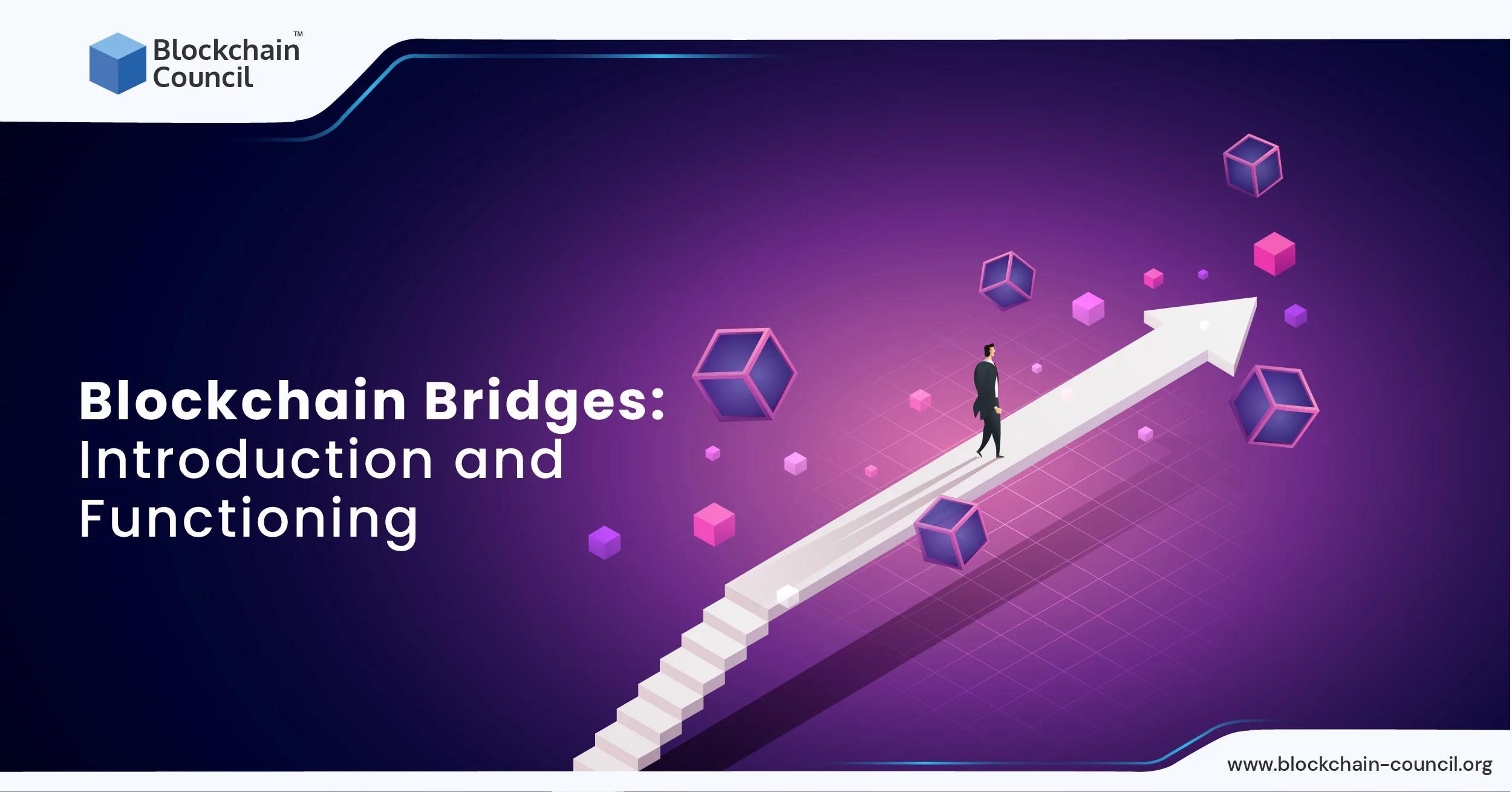
- Blockchain Council
- November 04, 2022
It was December 2008 when the concept of Blockchain spread to the world due to Bitcoin’s whitepaper release. An entirely new ecosystem unsurfaced, and people’s interest in programmable blockchains and cryptocurrency usage spiked high. Various newer blockchains based on different consensus protocols came into existence shortly afterward.
Blockchain promises the benefits of decentralization and freedom from institutional or individual control. The vast majority of blockchain networks are autonomous communities with separate economies. As a result, one of the unavoidable requirements for the ecosystem of decentralized applications is blockchain bridges. The limitation on interactions between several blockchain networks places boundaries on decentralization, the fundamental tenet of blockchain technology. This blog wil discuss the definition and operation of blockchain bridges. We’ll also demonstrate the concept through example scenarios to understand why blockchain bridging is a boon for developers, industries, and people worldwide.
Do you wish to have a career in Web3 development? Visit Blockchain Council today and enroll in any of our 50+ certification .
Blockchain Bridges Makes Interoperability Easier
Web3 has now evolved into a distributed ecosystem due to the introduction of side chains. But both of these original chains (L1) and (L2) scaling solutions come with their unique features and trade-offs. As more blockchain technologies are developed, there is an increasing demand for asset transfers. To accommodate this demand, we need bridges.
Blockchain bridges, aks cross-chain bridges or network bridges, are a mechanism developed to address the interoperability problem across blockchains. As things are, blockchains cannot automatically connect and work in isolation. Therefore bridges have become a crucial component of the blockchain business.
What does that mean?
Users cannot use Ether (ETH) and Bitcoin (BTC) on the Ethereum blockchain. User X is in a quandary if they wish to pay user Y for something, but Ethereum only takes ETH. They can’t send BTC to Y directly. Due to the interoperability provided by bridging solutions, they can still buy ETH or convert part of their BTC into ETH. It’s a disadvantage compared to regular fiat transferring/exchanging since fiat currencies and many banks and financial institutions can utilize credit cards.
Blockchain bridge has a primary function to make interoperability possible. Interoperability defines how well digital and data assets stored on a blockchain network can communicate. The new-gen Internet requires primary interoperability to function properly as a complete unit. Numerous protocols crearte a blockchain. Thus, blockchain bridges are a necessity to allow the transfer of data, value and information efficiently among different protocols.
Why is the need for blockchain bridges?
There are limitations to every blockchain. For example, to scale and satisfy demand, Ethereum needs rollups. For higher throughput at the expense of decentralization, Avalanche and Solana L1s are constructed differently. Every blockchain differs in terms of its rules and consensus mechanisms and develops in a closed environment. As a result, there is no natural interaction and free transfer of tokens between blockchains. The exchange of data and tokens between blockchains is made possible by bridges that connect them.
According to the official blog post on bridges from Ethereum, this allows dApps (decentralized applications) to access the advantages of various blockchains, enhancing their capabilities. It also permits the cross-chain transfer of assets and information (as the protocols currently provide more design space for innovation). Users can also utilize the advantages of other chains and access new platforms. In addition, programmers and developers from various blockchain ecosystems can collaborate to create newer user-facing platform solutions.
Get yourself to build a lucrative career in NFT development. Check out our NFT Developer course and enroll today!
Types of Blockchain Bridges
Blockchain Bridges are mainly of four types:
Trusted (Centralized) Bridges
- The operation of trusted bridges is dependent on a centralized organisation or system
- They place their trust in handling money and the bridge’s safety.
- The ownership of users’ crypto assets must be ceded to the bridge itself. The operator of the bridge is the ultimate authority.
Trustless (Decentralized) Bridges
- Algorithms and intelligent contracts are utilized to run trustless bridges
- Being trustless, they have the same level of security on both the bridge and the underlying blockchain.
- Smart contracts enable users of trustless bridges to keep control of their finances.
Unidirectional and Bidirectional Bridges
- Unidirectional bridges facilitate one-way irreversible asset exchange.
- Bidirectional bridges facilitate both-way asset exchange.
Multichain Crypto Bridges
- They are helpful when trading several tokens across many networks.
- Multichain crypto bridges facilitate seamless interoperability and exchange between various cryptocurrency wallets at any given time.
Functioning of Blockchain Bridges
Blockchain bridges have various functionalities. Transferring tokens is the most popular one. The crypto amount you wish to transfer is locked using smart contracts. In blockchain bridge, another crypto’s tokenized version is often referred to as a wrapped token. It is originally linked to the digital assets it points to and can be unwrapped whenever you want.
Firstly, you’ll need to determine the chain you want to bridge and the respective amount. The particular cryptocurrency then need to be deposited to the bridge’s generated address. The blockchain bridge will deliver you the wrapped token equal to the coin’s value once it has been received at the other end. Ethereum, Binance bridge, Avalanche, and Polygon PoS are some of the most famous bridges available.
For example, if you need to exchange $BTC for $ETH, you only need to deposit the $BTC into the bridge and choose to withdraw in $ETH to convert your Bitcoin to Ethereum. The bridge will create an identical quantity of $ETH on the Ethereum blockchain while locking the $BTC in a smart contract. The bridge would employ a mint-and-burn mechanism to limit the number of tokens available, the bridge would employ a mint-and-burn mechanism. The amount will be deducted according to the minting fees of the bridging solution. Once bridged, you can withdraw your $ETH.
Your $BTC can still be “bridged” through a centralized exchange (CEX) if you don’t want to use a bridge. To sell the $BTC for $ETH and then transfer it out, you must first transfer it into a CEX. This entire procedure is longer and more laborious than simply using a blockchain bridge. Blockchain bridges generally assist in the quick and inexpensive movement of tokens between blockchains.
Are Blockchain Bridges Safe?
Both reliable and trustless methods may have underlying technological faults. To be more precise, a trusted bridge’s centralized feature has a primary pain point, but trustless bridges are vulnerable to flaws in the application and the underlying code. But, if there is any issue with the smart contract, it is almost certain that someone will try to take advantage of it. There are architectural flaws in both trusted as well as trustless platforms that compromise the security of the blockchain bridge in various ways.
Hackers are developing their skills as the value of the industry and user base continues to expand. To match the security aspects of the Web3 space, conventional digital malpractices like social hacking and phishing have also been upgraded to target centralized and decentralized protocols.
Advantages Of Blockchain Bridges
- The most significant advantage is improved interoperability.
- As few blockchain bridges can manage several transactions, they also help address the scalability difficulties.
- Blockchain bridges provide advantages to users through cheaper and quicker transactions.
- Easy workability for developers. Developers from different domains can effectively collaborate to integrate bridging functionalities into dApps and facilitate increased scalability, interoperability and performance.
Risks associated with Blockchain Bridges
While they undoubtedly provide numerous advantages, they also come with certain limitations.
- Cyberattacks and hacking attempts: Attackers, many times, have stolen massive sums of cryptocurrency from cross-chain bridges by exploiting the deficiencies within the smart contracts.
- Centralized thievery: Centralized/trusted bridges can hypothetically steal assets anytime they want due to having complete authority over the user assets.
- Bottlenecks elated to transact ability: The processing capacity constraint of a single chain might stymie extensive blockchain interoperability.
- Trust and security misalignment between respective chains: Blockchain bridges may reveal the risks associated with the fundamental mechanisms of the respective chains due to trust disparities. Since blockchain bridges link multiple blockchains, the robustness of the connected systems gets misaligned.
Conclusion
Interoperability has the potential to be the catalyst for Internet innovation. Improving blockchain networks’ interoperability and their widespread adoption depends on using blockchain bridges. The number of users, bridges, and overall transaction volume on these bridges have all increased exceptionally. As the Internet transitions to Web3, the blockchain bridge will also keep expanding in the future. Innovations are constantly being introduced to the blockchain sector. Blockchain bridges come under the post-segment. Some do not find much success, while others establish themselves highly successfully. The ecosystem functions better as a whole when these bridges support it by making it more interoperable and cohesive.
What’s in it for me, you might say. Well, you can enjoy better services, increased convenience, and perhaps the opportunity to build a lucrative career by mastering blockchain development. Discover more about the advents of Blockchain technology. Choose from any of our 50+ advanced certification and enroll yourself. For more details, visit Blockchain Council.




































































 Guides
Guides News
News Blockchain
Blockchain Cryptocurrency
& Digital Assets
Cryptocurrency
& Digital Assets Web3
Web3 Metaverse & NFTs
Metaverse & NFTs
